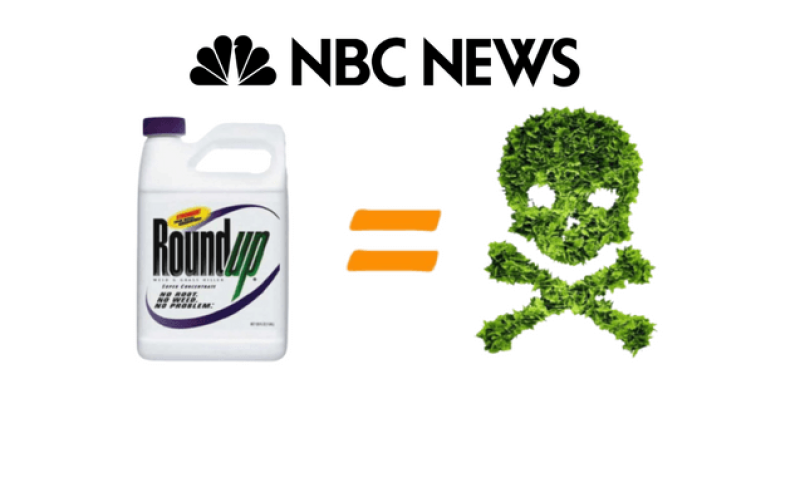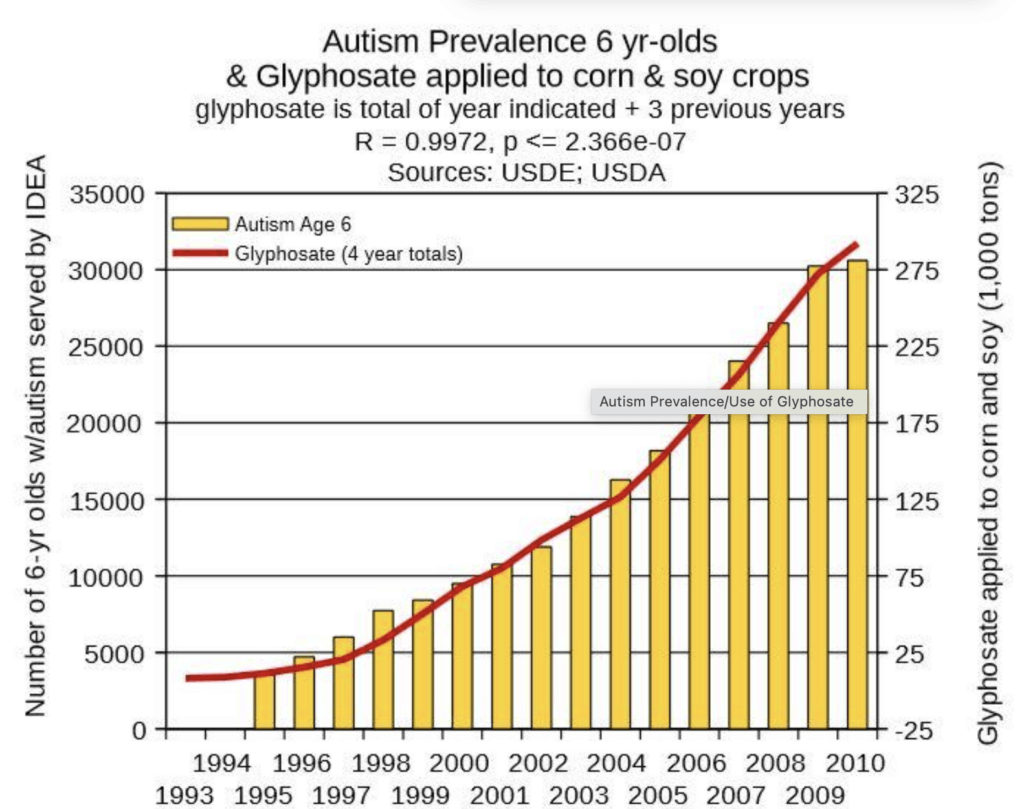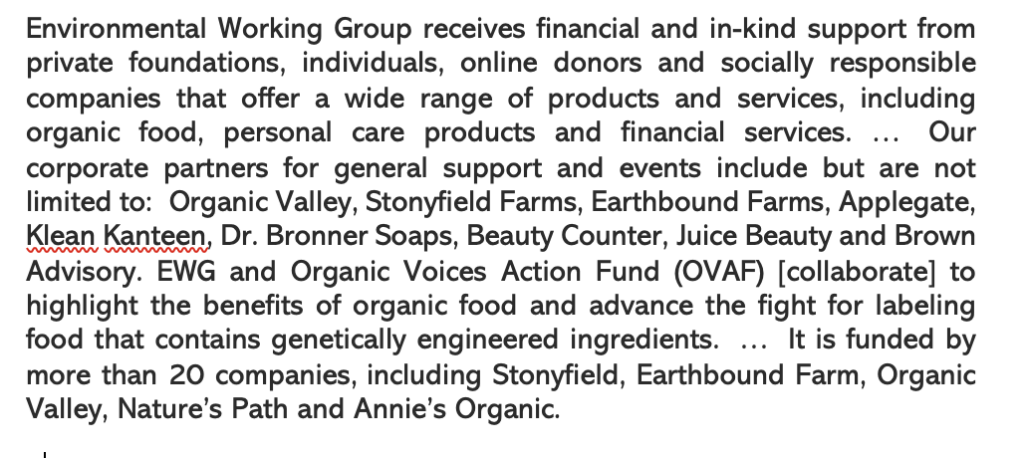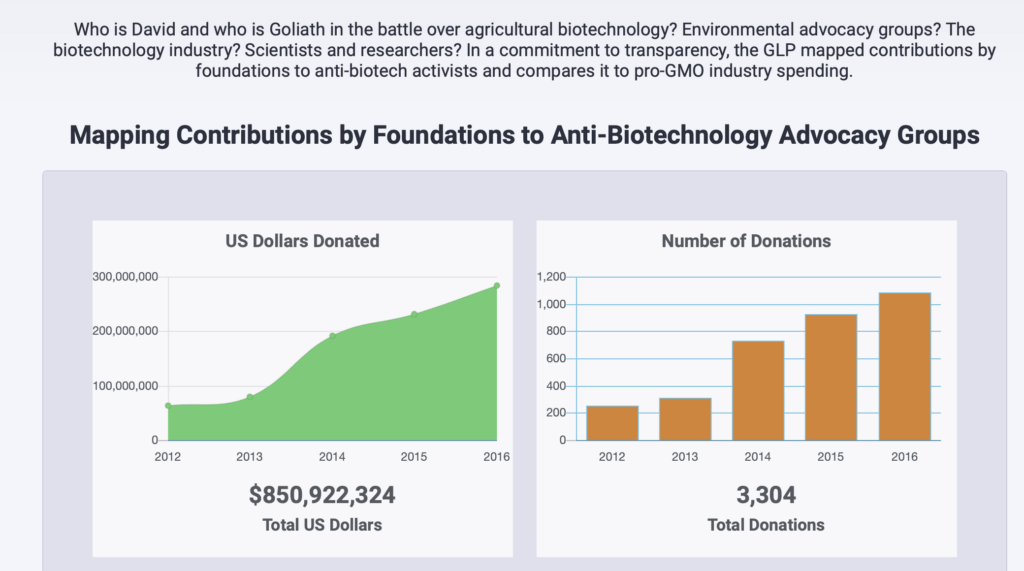What happens when a media outlet leans into clickbait? It’s annoying but generally harmless entertainment. When it’s a resource that readers trust to ‘tell it straight’ in this fake news era, it graduates to annoying. But when it grossly misrepresents overwhelming evidence in addressing contentious science issues, such as the safety and reliability of our food supply, and passes along harmful disinformation — that’s inexcusable.
That’s what happened earlier on October 10 in an article by Danica Jeffries on the NBC News site earlier this week. Let’s cut her slack up front as she is not a reporter. She is new at the network, and works as a graphics designer and not a reporter. Rather, let’s direct a critical eye, or ire, at her employer, NBC News, who inexplicably let a green and editorially untrained reporter-in-training put her name on a scientifically-embarrassing, error-filled report about one of the more controversial issues in popular culture today — the alleged dangers posed by eating foods with micro-traces of the herbicide glyphosate (a.k.a. “Roundup” in some commercial formulations).
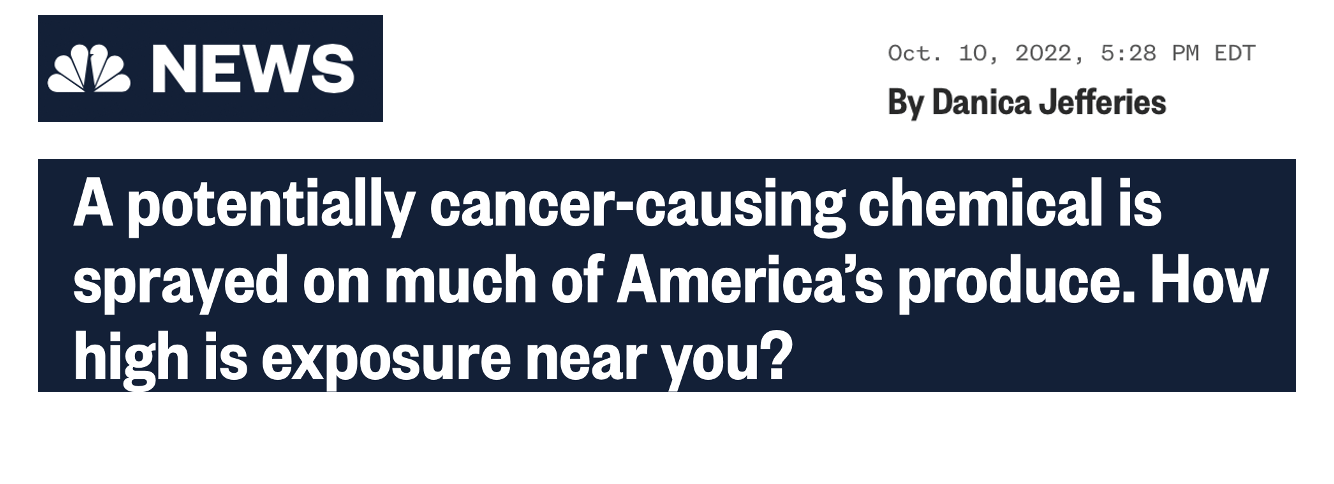
Let’s break this story down. It should be note that the basic background facts on glyphosate’s history of use are well available on serious science sites: this fact sheet put out by the National Pesticide Information Center at Oregon State University is relied upon by governments and universities; it would have served mr. Jeffries well to have consulted it. (Advice: avoid advocacy group sites — stick to independent governmental and global agencies, else you will soon find yourself down an anti-science rabbit hole.) As we lay out the evidence, you will see there is no serious controversy over glyphosate’s effectiveness and safety among mainstream scientists anywhere in the world — it’s almost entirely a manufactured controversy.
Glyphosate is what’s known as a non-selective herbicide, meaning that it kills most plants. It was first registered for use in 1974. The weedkiller has been applied on farms and in forestry, on lawns and gardens, and even in industrial areas to control weeds for almost half a century.
The herbicide became a lightning rod among anti-biotechnology activists in recent years for one reason — it’s become a proxy for an attack on what is simplistically called ‘mainstream agriculture’ and its embrace of both genetic modification and synthetic chemicals. It’s sometimes hard for people, and frankly many unschooled writers acting today as journalists, to get a handle on the risks and rewards of GM crops, as the science can be challenging to some. If you are ideologically opposed to technological tinkering of seeds to address sustainability and nutrition challenges, attacking the chemicals often paired with them resonates more with journalists, activists and the general public. As a result, even as the controversy over GM crops has faded, farm chemicals have become the surrogate target for advocacy groups, almost all of whom promote organic farming as the ‘safe’ alternative. (That’s not factually accurate, but it’s a subject for a future story.)
Critical analysis
To say glyphosate has an almost 50-year history of safe use, especially relative to its enormous benefits (e.g., it’s cheap and effective, and there are literally zero competitive products) would be an understatement. The ONLY actual long-term study of human exposure — the Agricultural Health Study — tracked almost 45,000 applicators, such as farmers, who used glyphosate, sometimes daily, over decades. Its conclusions? “No statistically significant associations with glyphosate use and cancer.” None.
Keep that fact in mind — and we will soon lay out the unanimous conclusions of 20 other independent assessments by independent research agencies from every corner of the globe — as we discuss NBC’s embarrassing foray into advocacy “reporting” (quote marks intended).
Let’s start out with the title of the NBC piece: “A potentially cancer-causing chemical is sprayed on much of America’s produce. How high is exposure near you?” It’s wrong.
Glyphosate is not sprayed on “much of America’s produce”. In fact, it is used with only one produce product in the US, and it’s not ‘sprayed on’ it. The only item in which glyphosate was part of the growing process that might show up in your produce aisle might be a tiny percentage (less than 10%) of US-grown sweet corn. It is sprayed early in plant development and never comes close to touching a corn cob. It’s applied in what amounts to in agricultural terms as a thimble full: about ¾ of a pound per acre. It’s mostly used in early-season weed control, long before the ears of corn have formed.

So, let’s stop with the hysteria statement that our produce is endangered by traces of glyphosate. It’s factually improbably at best. In practice, the herbicide is applied to weeds and young plants, namely soybeans, corn, cotton, canola and sugar beets, early in development. The weeds die, the crops survive. Most of these crops are generally not sold for human consumption, but to feed animals. In sum, these commodities are not “produce,” but are agronomic crops, destined for livestock feed or to be broken down into their components, like oils, starches and sugars. They are not fresh produce.
And, as the evidence suggests after literally trillions of meals grown with herbicide-resistant crops has proven, they are perfectly safe for the animals that consumer them. [Read: “The Debate About GMO Safety Is Over, Thanks To A New Trillion-Meal Study,” which examined the impact of GM crops on farm animals who have consumed them for more than 25 years.]
Europe, which has restricted the sale of many genetically modified crops for political reasons, is actually the largest regional purchaser of GM products in the world – for feed animals grown for slaughter or dairy production.
The EU would not be exposing an entire continent to the ‘mortal dangers’ posed by GM crops with glyphosate traces if there was any evidence of potential harm to humans who consume these foods. European farmers continue to buy GM crops with full backing of the European Union because every major science agency in Europe, bar none, has concluded these foods are safe.
Glyphosate is used in some circumstances to ensure uniform maturation of some grains and dry beans. The only produce mentioned in the article are carrots and sweet potatoes, which would die if treated with glyphosate sprays. [Where were you NBC fact checkers, letting this poor intern humiliate herself in one of her first articles?] They cannot be grown in the presence of this herbicide.
It’s clear that the title is alarmist and deceptive and frames the avalanche of inaccuracy to come. What about the reference in the title, elaborated in the piece itself, to glyphosate as “potentially cancer-causing” or “toxic”? Well, much less acutely toxic than table salt. Or Advil. Or coffee for that matter.
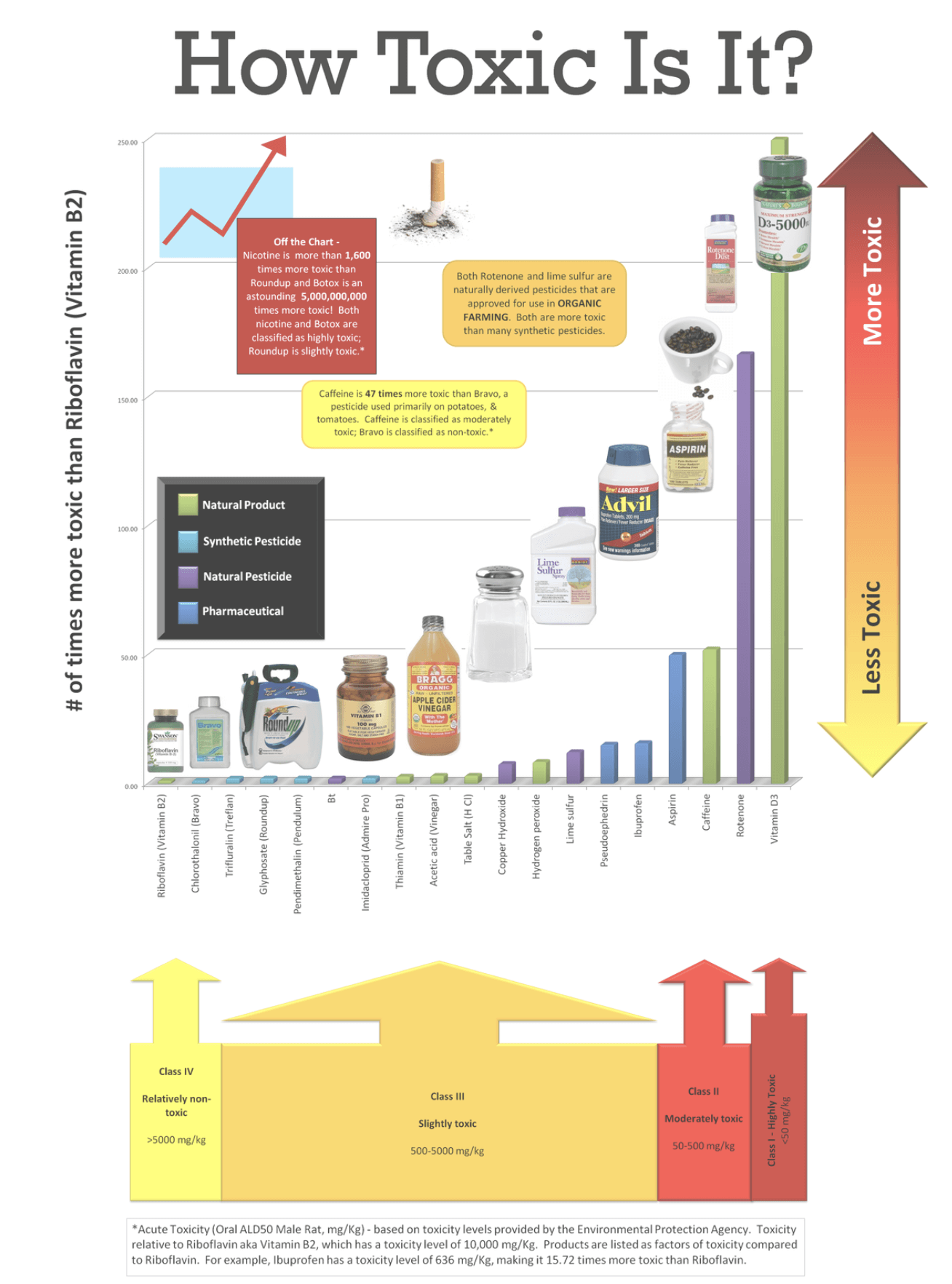
While we can generate a hypothesis that glyphosate at exposure levels not found anywhere in normal usage anywhere in the world is potentially cancer-causing, there is no good evidence that it actually does cause cancer. Certainly, there are no data based on analysis of animal models or massive epidemiological studies.
So where does NBC’s claim that glyphosate is “potentially-cancer causing” come from?
The NBC News intern noted correctly that the EPA has concluded (twice in separate independent evaluations) that the herbicide poses no risk to human health at levels encountered, and notes that there is no evidence that it causes cancer, which conflicts with the clickbait headline of “potentially cancer causing”.
(Note that the mainstream science community as determined by the American Association for the Advancement of Science has long since concluded that fruits, grains and produce grown using genetically modified seeds, including those protected during early growth by glyphosate, are safe – in fact, according to a PEW poll, the consensus over the safety of GMO foods is stronger than the consensus that climate change is mostly human-caused.)
But NBC then indulges in what can only be seen as willful manipulation of the accepted science. While ignoring the plethora of regulatory evaluations, the story relies solely on one outlier, and that is even exaggerated and misrepresented. In 2015, International Agency for Research on Cancer, an advisory body of the World Health Organization, concluded that glyphosate was “probably carcinogenic” — but not because of traces in our food, as there was no strong evidence of that based on applicators who might have used it over decades.
Recall our mentioning above of the Agricultural Health Study, which studied 45,000 actual applicators over decades? It found no evidence in the real world. In fact, the levels of cancer in the counties in the U.S. Midwest where glyphosate was most widely used was actually lower than among the general population. Intriguingly, IARC chose to exclude the only actual real-world longitudinal study, substituting in others, and only ridiculously weak ones (some of which showed glyphosate posed no harm or improved applicator health.) Reuter’s investigative reporter Kate Kelland wrote a scathing investigative piece about IARC’s bizarre decision to exclude from its analysis the single most important glyphosate study.
What did IARC finally conclude? IARC’s research did not evaluate real-world exposure; rather, it relied on laboratory studies of rodents, because IARC judged the epidemiology (i.e., human data) to be “limited.” (In fact, the human data were contradictory, as one studies showed those exposed to glyphosate had fewer cancers). Writing for the GLP, epidemiologist Geoffrey Kabat deconstructed the limitations of IARC’s glyphosate research here, summarizing:
When all the rodent studies are examined, there are more inverse associations of glyphosate exposure with tumor incidence than there are positive associations. (IARC simply ignored the inverse associations and focused on a few weakly positive associations). There is also evidence that, in the course of editing, positive evidence was strengthened and exculpatory evidence was curtailed.
Note also that IARC as an institution is unique among global chemical evaluation agencies in that it focuses on ‘hazard’ while regulatory and oversight agencies evaluate real-world risk. What’s the difference? Risk measures what is likely to cause harm in the real world; for example, what’s the dosage in a chemical that could harm the body. Hazard is a much less onerous standard as it looks only at the ‘potential to cause harm’ — which pretty much means almost anything. In the case of glyphosate, IARC’s determination was based on the potential to cause genetic change in cells in vitro, and some inconsistent trends in laboratory animals.
No surprise that using its hazard standard, IARC has reviewed more than 1,000 situations, from exposure to sunlight, going to the barbershop, eating salty fish, drinking wine or working the night shift — you get the idea — and has only once concluded that the activity or substance was not a possible or likely carcinogen. Even using IARC’s loosey-goosey hazard standard, the embattled agency found that evidence of glyphosate’s possible carcinogenicity was less robust than for eating bacon, using oral contraceptives or sipping on a Budweiser. And be wary of drinking hot coffee: using IARC’s hazard standard, it’s doubly carcinogenic, because of the 30 or so ingredients in even cup of Joe and the fact that hot beverages fall into the same IARC category as DDT. NBC News ignored reporting that essential context.
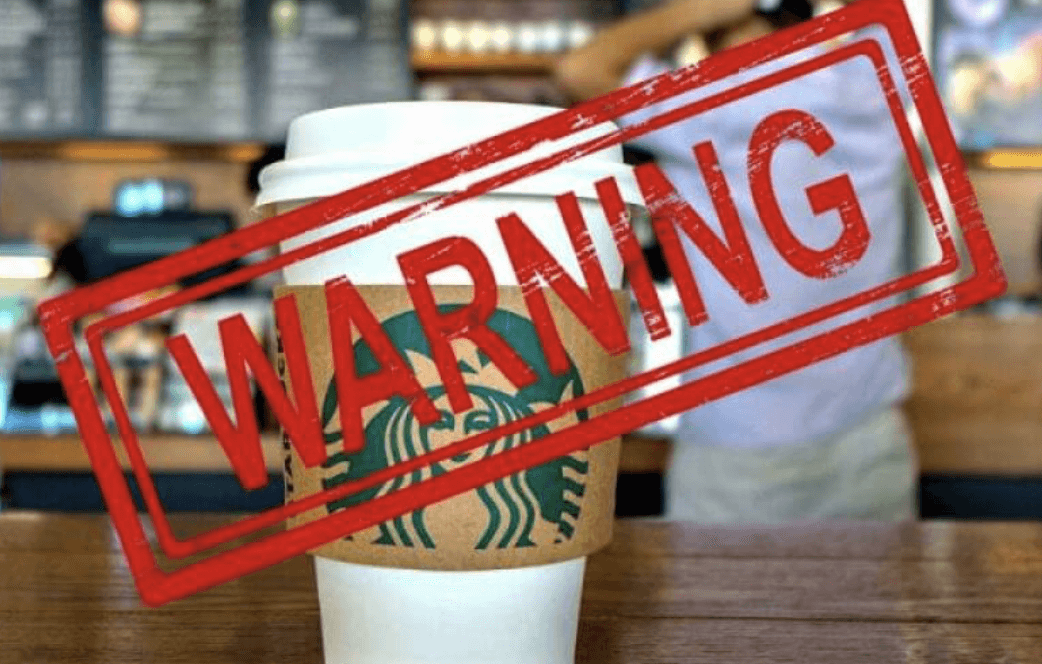
Using IARC’s measuring stick, literally everything is potentially carcinogenic — from getting a suntan to sipping a glass of Bordeaux — and could be subject to the kind of ban that activist groups, and some countries, now want to impose on glyphosate.
It’s no wonder that not one regulatory agency in the world relies on IARC’s analysis as conclusory when setting exposure standards for chemicals or other situations. Even IARC, at least in its official statements, doesn’t believe its preliminary and limited findings should be followed. “The IARC evaluations are important in enabling governments and international regulatory agencies to conduct risk assessments,” the agency has said.
Which is exactly what subsequently happened.
Global regulatory agencies stepped in and performed the real-world research that is not IARC’s purview. In the wake of the hazard assessment, every major international, independent regulatory agency in the world re-examined the data over glyphosate, and in many cases embarked on fresh research to leave no toxicological or epidemiological stone unturned. That includes the Environmental Protection Agency, European Food Safety Authority, Food and Agriculture Organization in a joint study with the World Health Organization, European Chemicals Agency, German Federal Institute for Risk Assessment, and others. Their conclusions were unanimous — not one concluded that exposure to glyphosate, either to workers who sprayed it or the general population who may have consumed micro-traces in the parts per trillion, are in danger of contracting cancer. Not one.
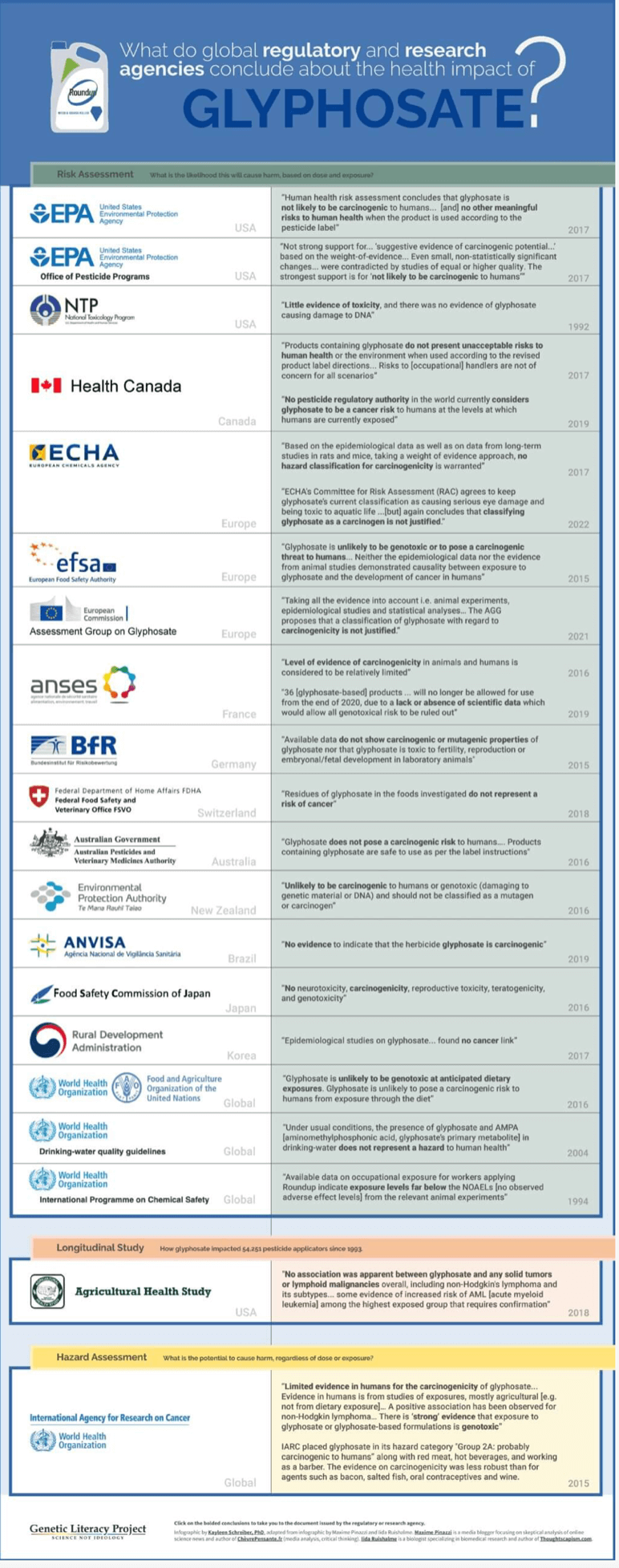
[Click here to review the complete chart, where you can further click on the bolded conclusions to take you to the documents issued by the regulatory or research agencies.]
One more important heads up to readers that NBC News inexplicably left out. Even with the limitations inherent in its hazard-based methodology (almost everything is potentially carcinogenic), IARC was still about to conclude for only the second time in its history that a substance it was evaluating was not potentially cancer-causing. That was its initial finding, internal IARC documents show. But days away from releasing its fine, exculpatory finding, IARC edited out the conclusion that glyphosate was not a probable carcinogen. A Reuters investigation exposed the scandalous and still unexplained last-minute reversal.
The man who orchestrated the reversal — Dr. Christopher Portier — would later become a paid consultant to the Church of Scientology’s Baum Hedlund law firm, which took the lead in drumming up glyphosate tort cases, and oversaw the first three glyphosate trials. After leaving IARC, Portier earned at least $160,000 by misinforming juries that glyphosate could kill them. (Here is his story and the global damage his last-minute, intervention has caused.)
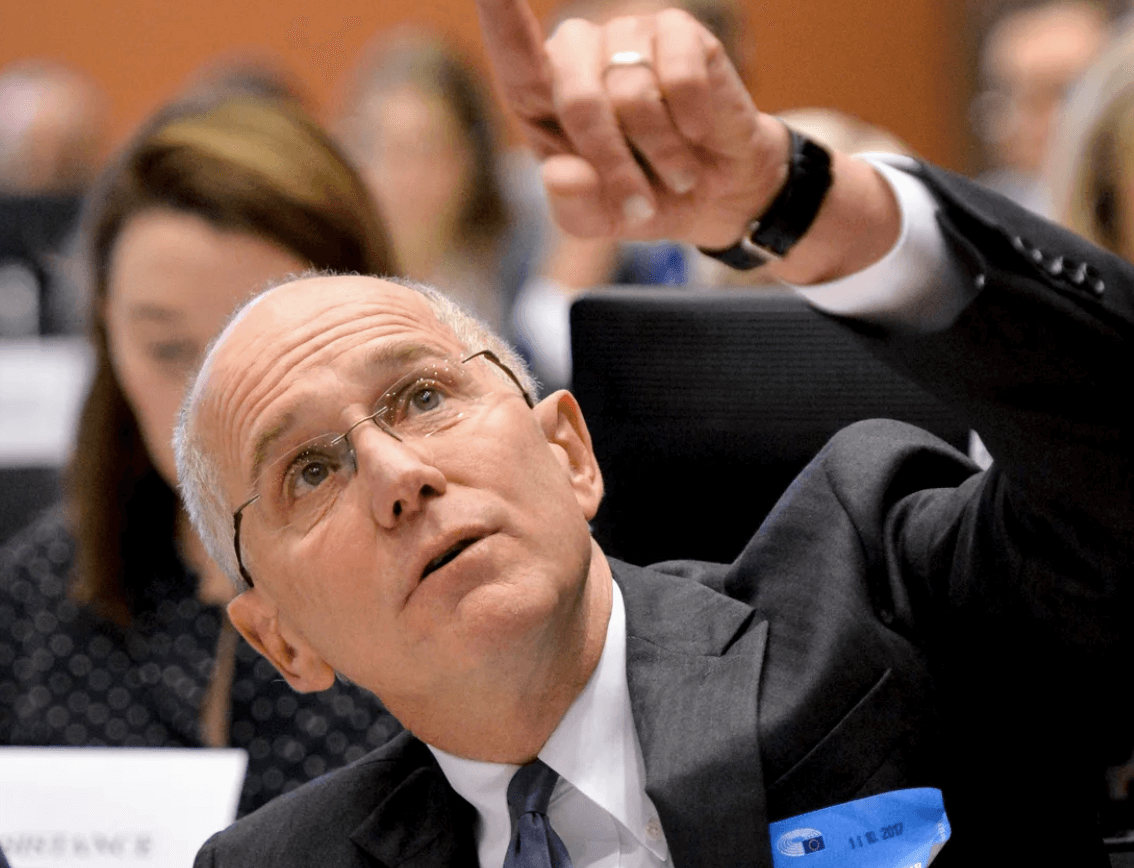
Seven years after IARC’s problematically formulated hazard assessment, activist groups and tort lawyers have turned this decision into a cash machine — and the damage the misrepresentations of the decision to the agricultural industry and the global food supply is incalculable.
Mistaken speculative reporting
With ‘hazard’ rather than evidence and risk as the standard, IARC opened the door for all kinds of ambiguous claims. Activist groups and tort lawyers, now abetted by sloppy reporting, have had a field day.
NBC News fell into the trap of suggesting glyphosate might be an “endocrine disrupter”. There is zero real world evidence, but that did not deter the reporter. Her story cites an endocrine disruption claim in which researchers examined cells in a petri dish exposed to glyphosate. Zero real world data; pure speculation. Over the subsequent decade, no follow-up work has been produced and other reports refute this finding, so referring to the herbicide as an endocrine disruptor at the minimal levels of exposure is, to be generous, highly debatable.
The article also hyped a highly-controversial meta-analysis from 2019 which associated glyphosate with non-Hodgkin’s lymphoma. Note that researchers examined an association and not a correlation — a huge difference. Mixing up the too, which a a favorite tactic among illiterate activists, generates press but disrupts empirically-grounded science. This peer reviewed critique of the meta-analysis in Cancer Causes Controls uncovered a smorgasbord of selectively-presented data. [Read this GLP analysis by epidemiologist Geoffrey Kabat], this research is ‘junk in, junk out’ science.] No other study — and there have been thousands — has ever found this link (and even here an “association” and not a “correlation” was identified). To bolster its case, the NBC News article cited isolated papers that suggested glyphosate is ‘associated’ with ‘disrupting the microbiome,” and also might be an endocrine disruptor.
Confusing the public about the difference between ‘association studies’ and ‘correlation studies’ has been a favorite tool of activists attempting to throw clouds over settled science. As the IARC report on glyphosate began circulating seven years ago, a once obscure MIT scientist in the artificial intelligence lab at MIT. Stephanie Seneff, generated charts purporting to prove that glyphosate use has led to a sharp increase in autism — a causal finding wholly absent from science research.
Seneff’s photo-shopped chart circulated for weeks on tens of thousands of sites, but was soon subject to universal scorn. Associations , most of which are random, prove nothing. After all, as one wag noted when crunching numbers on autism and organic food, an even stronger association case can be made that organic farming is the real culprit driving mental health issues among the youth. Here’s a bogus association chart to prove it!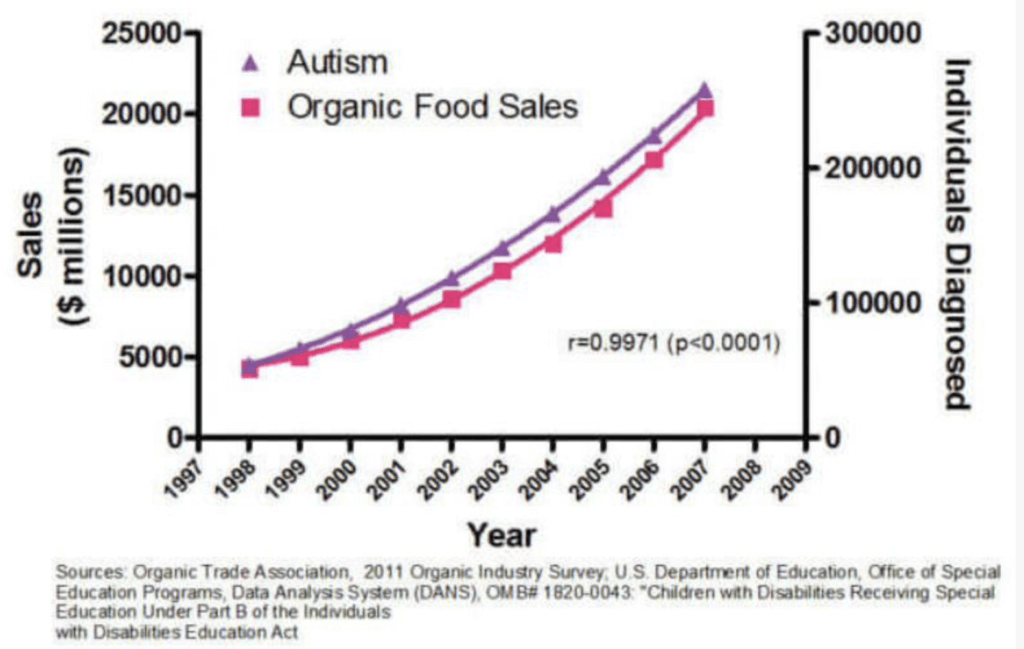
Lesson learned: One can massage association data to make any point. When you see charts cited by anti-biotech activists, you know they’ve lost the science debate. When you see them displayed in globally-circulated NBC News accounts, you know mainstream journalism is disconnecting from consensus science. NBC News never makes it clear how any of these sparse studies cited above address the questions at hand: are humans endangered by micro-tiny exposures from chemicals used to control fields pests thousands of miles away from dinner plates? Are workers in the field endangered? A look at the data doesn’t remotely establish those premises.
The article then builds a case for concern from implied exposure, but what do the data say? Glyphosate use has increased substantially since 1996, when genetically engineered plants resistant to glyphosate first came to market. But the article does not deign to note that the increase in the use of glyphosate because of its effectiveness and safety corresponded with a sizable reciprocal decrease in the use of other herbicides with greater toxicity. As glyphosate use went up in food related crops such as corn and soybean, use of other herbicides with greater health and environmental precautions went down proportionately, an environmental win.
Herbicide acute hazard quotients, 1990-2014, Nature Communications, 2017
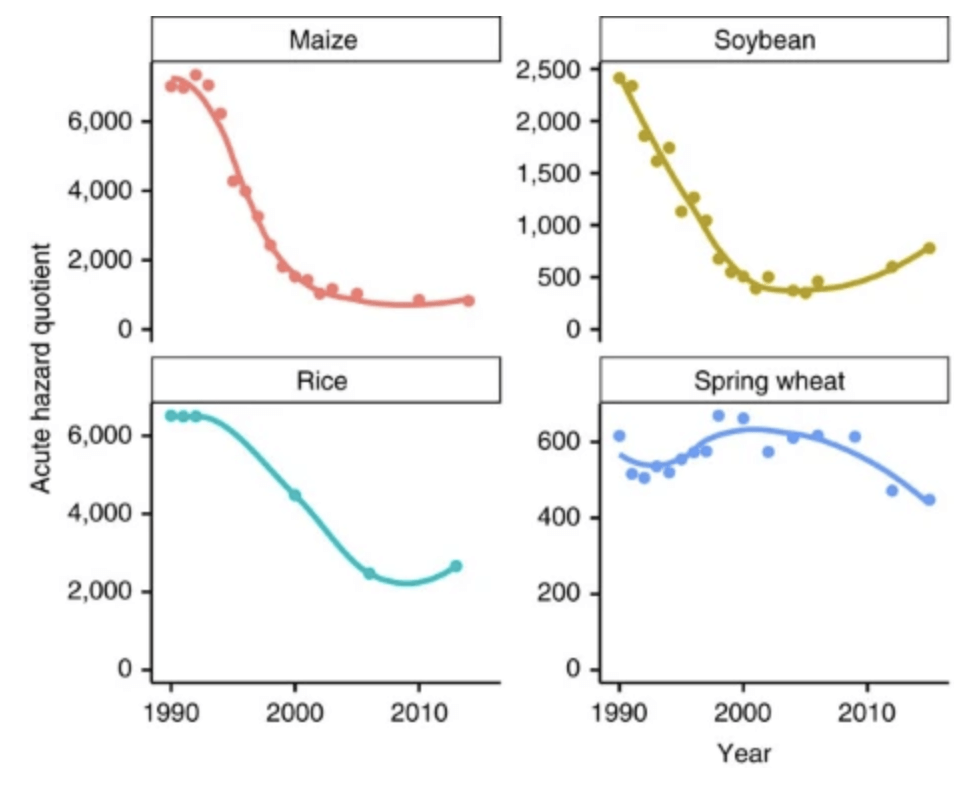 The NBC report botches the interpretation of other data. It cites the nice work by the United States Geological Survey stating that glyphosate is detectable in air and rain samples, suggesting this is evidence of risk. It’s not. The highest level detected in air was 9 parts per billion, equivalent to just 9 seconds in 31 years in a cubic meter of air. No responsible scientist anywhere in the world would consider those micro-trace levels as a health threat — and this was the peak detection measured while the chemical was being sprayed. To frame these levels as a danger to humans is purely false. (Note, the detections were also made adjacent to a field where the herbicide was applied, not in downtown Des Moines.)
The NBC report botches the interpretation of other data. It cites the nice work by the United States Geological Survey stating that glyphosate is detectable in air and rain samples, suggesting this is evidence of risk. It’s not. The highest level detected in air was 9 parts per billion, equivalent to just 9 seconds in 31 years in a cubic meter of air. No responsible scientist anywhere in the world would consider those micro-trace levels as a health threat — and this was the peak detection measured while the chemical was being sprayed. To frame these levels as a danger to humans is purely false. (Note, the detections were also made adjacent to a field where the herbicide was applied, not in downtown Des Moines.)
Similarly, reports of detection in foodstuffs indicate it is present at vanishingly small amounts. The CDC analysis of glyphosate in urine has been addressed; it’s detectable at levels far, far lower than could possibly impact our health. This 2014 report shows tiny amounts detected in 80% of urine samples — levels near a threshold of 200 parts per trillion, equivalent to about three minutes in 31,000 years. [To her credit, the reporter correctly notes that the CDC says these levels are inconsequential, but by framing this report amidst a slew of the exaggerated studies she otherwise cites conveys the opposite.]
Detractors with a long history of science rejectionism are uncritically given final say
NBC News failed to interview scientists that actually study the chemical at independent government agencies around the world; rather the report connected with known ideologues who have made controversial and lucrative careers disparaging mainstream technology. They include Dale Murphy of Food Democracy Now, and Bill Freese from the Center for Food Safety (which recently sued the EPA to denounce the agency’s latest evaluation reaffirming its conclusion that glyphosate is safe as used). The article quotes Robin Mesnage, a co-author of the retracted then republished un-reproducible 2014 paper on the toxicity of glyphosate, a poorly designed experiment with missing controls and photos of tortured, sick animals.
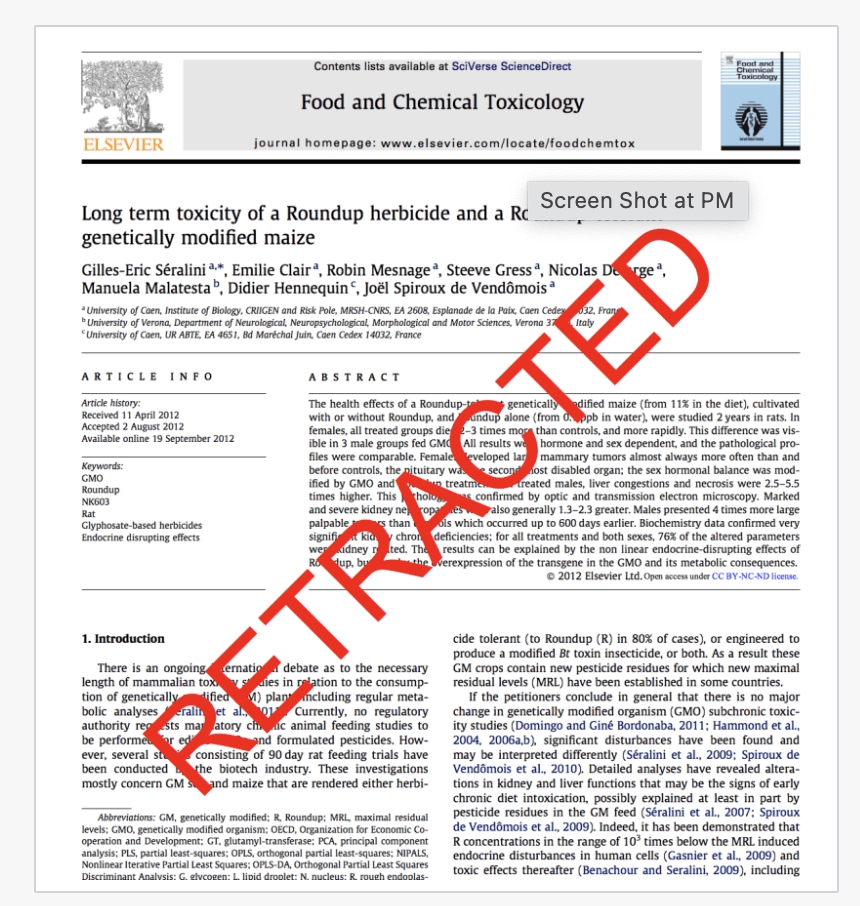
NBC News relied on selective omission, misrepresenting risk from published studies, and interviews with perennial opponents of technology to support her thesis of risk from a safe, low-dose herbicide. It is the kind of bias and misinformation that poisons public opinion. No surprise that this clickbait article, strewn with false information and extrapolation, took off in social media and was picked up by other mainstream publications which assumed — falsely — that a news organization as traditionally reputable as NBC would fact-check an article by a graphics intern with zero background on this subject.
This lazy, biased work has now been viewed millions of times, further reinforcing a scientifically false narrative about the dangers of our conventional food supply.
Who is behind the attack on conventional agriculture and our global food supply?
Organic activists are relentless in trying to make the case that one of the world’s safest and most effective weedkillers is actually the ‘most evil chemical in the world’. What is their long goal? To promote the organic industry, whose entire premise rests on the false belief that ‘regenerative agriculture’ can feed a globally expanding population while climate change further disrupts food and farming.

Many if not most of the advocacy groups that attack the use of synthetic chemicals in agriculture — Organic Consumers Associa (OCA), Environmental Working Group (EWG), US Right to Know, Center for Food Safety, Pesticide Action Network, ETC Group and the dozens of GM rejectionist NGOs such as GM Watch and the Non-GMO Project — operate on the fringes of science but are often quoted by activist sites and less discriminating news outlets. Many of these groups and organizations — EWG and US Right to Know most prominently — also work openly or covertly with vaccine denialists or ‘natural medicine’ promoters, such as Joe Mercola (a key funder of some of these groups).
Do these organizations believe the pseudo-science they spread? Perhaps, but make no mistake, promoting misinformation about science on a massive scale has proven lucrative. Many fellow travelers, from Robert F. Kennedy, Jr. to the OCA, work closely with law firms, such as the Church of Scientology’s lead attorneys, Baum Hedlund. BH works hand-in-glove with anti-GMO groups and individuals cited in the NBC News piece. It filed and won the first three glyphosate cases and jump-started the nationwide surge in filings targeting glyphosate that now tops 100,000. High-end ambulance chasing is Baum Hedlund’s bread and butter. During the 1990s, it initiated the strategy of using ‘scare science’ to go after the makers of Prozac, accusing it of ignoring the chemical’s angers. The FDA rejected the claims, but as in three glyphosate cases so far, BH was able to win billions of dollars in court victories and settlements. In partnership with RFK, Jr.and organic groups, they are well on their way toward replacing this tort extortion strategy.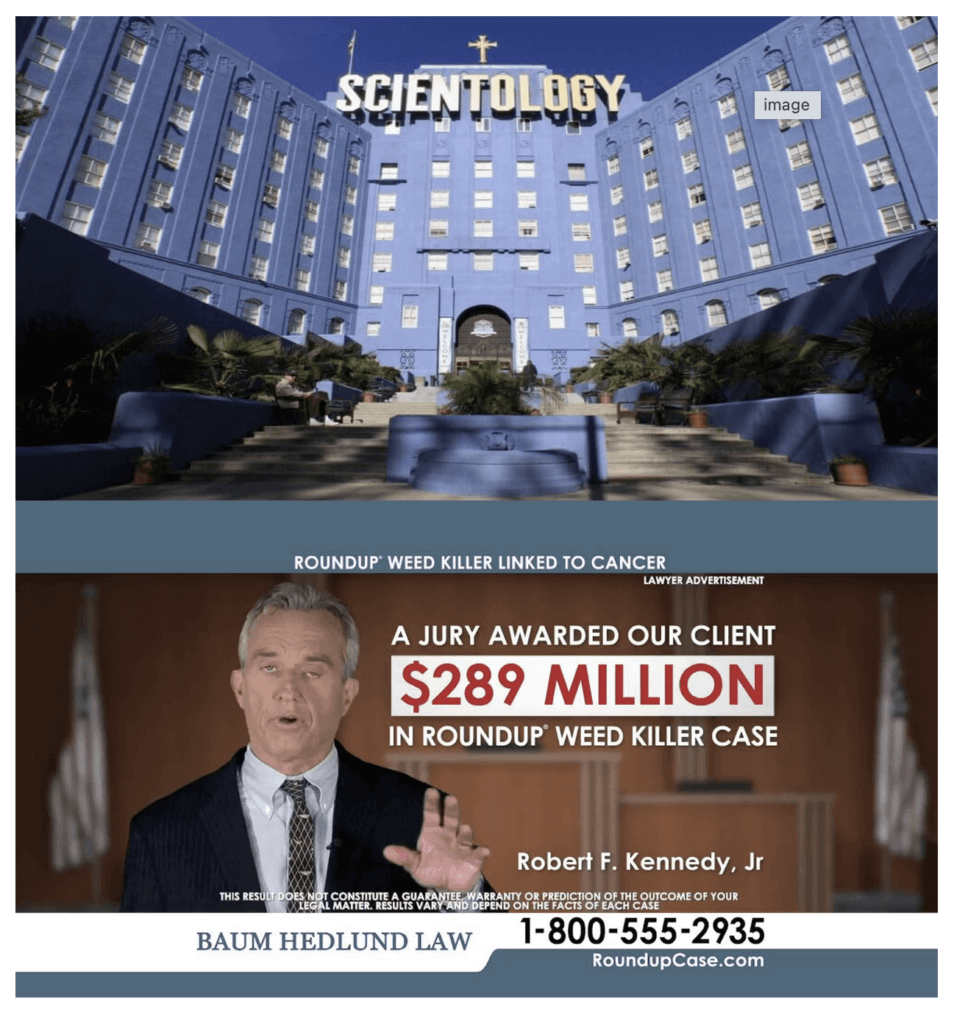
Foreseeing a huge potential payday, the Church of Scientology resuscitated that strategy beginning in 2015 to target glyphosate’s maker in a coordinated campaign with anti-GMO activist groups, including US Right to Know and the Organic Consumers Association, among others.. BH clients won the the first three suits against Monsanto/Bayer filed by clients claiming glyphosate caused their cancers. The agri-businesses have won the last five cases, but there’re potentially tens of thousands of more cases yet to be litigated.
Shill attacks from ‘dark money’-funded extremists in the organic industry
The anti-GM advocacy groups rarely offer solutions to our global food challenges; as allies to the organic industry, which is undergoing a rebrand as regenerative agriculture, they are focused mostly on suppressing agricultural tools rather than choosing the best tools available to meet the varied range of sustainability challenges. They are not ‘let’s use all tools in the toolbox’ problem solvers; they are ideologues, almost entirely funded by the organic industry. For example, this is who funds EWG, according to its donation page. Unlike the GLP’ transparency page disclosures, Enviornmental Working Group does not break out their donations. Rather, they present a blurred summary statement with no numbers … which even in its watered down fashion makes it clear they are proxies for multi-national organic companies that would benefit most from ridiculing mainstream farming practices:
Almost all of the groups dismissive of synthetic crop chemicals (these same groups ignore the toxic concerns raised by ‘natural chemicals’ because most people wrongly believe natural chemicals are intrinsically safer than targeted synthetic ones, when the opposite is sometimes true) are funded by the organic industry and its partners. The GLP provide an accessible resource that tracks the money-stream from organic groups to organizations like OCA and EWG.
Watch what unfolds in the coming weeks as this analysis/critique of ‘organic dark money’ seeps into public consciousness. We will see ad hominem tweets and attack articles on the credibility of the two authors of this piece and the Genetic Literacy Project itself (which has existed for ten years as a registered nonprofit covering the biotech revolution, monitoring vaccine rejectionists, helping the public understand the CRISPR revolution in biomedicine, and critically examining the interaction of technology in food and farming). Will they provide substantive responses to the factual reality that not one independent risk agency in the world embraces the notion that glyphosate traces in our food pose harm to humans or animals. Not one.
It is no surprise that juries evaluating the ‘glyphosate-causes-cancer ‘claims are finally catching on to this extortion racket. After losing its first three ‘glyphosate causes cancer’ cases in tort friendly courts in California — all financed by the Church of Scientology in cooperation with and with funding from the organic industry and Robert F. Kennedy, Jr. — juries are now consistently siding with science. Simply said, these anti-biotechnology long ago left empirical evidence behind years ago. As we noted above, after IARC released its controversial findings in 2015, every major health agency in the world faced pressure to reevaluate glyphosate. Maybe they missed something, they said. At great expense, every single one, including multiple full agencies at the United Nations itself (see chart linked earlier in the piece) reviewed IARC’s research and scrutinized thousands of additional studies. Their findings were unambiguous and unanimous. As Health Canada summarized in its most recent evaluation:
Simply said, these anti-biotechnology long ago left empirical evidence behind years ago. As we noted above, after IARC released its controversial findings in 2015, every major health agency in the world faced pressure to reevaluate glyphosate. Maybe they missed something, they said. At great expense, every single one, including multiple full agencies at the United Nations itself (see chart linked earlier in the piece) reviewed IARC’s research and scrutinized thousands of additional studies. Their findings were unambiguous and unanimous. As Health Canada summarized in its most recent evaluation:
No pesticide regulatory authority in the world currently considers glyphosate to be a cancer risk to humans at the levels at which humans are currently exposed.
This NBC News story and others porting similar agri-business conspiracies appear almost weekly; they are scandalous. In this instance, a major news organization did not fact-check an enormously consequential article. That’s a failure of journalistic ethics and a violation of long-standing conventions about balance and objectivity. Moreover, the news network left a well-meaning but inexperienced reporter out to dry, endangering her career. And by publishing a slanted and oftentimes demonstrably false representation of the current state of the science on this important technology, the network endangers public health.
NBC News should be embarrassed and humiliated. Will it address its own credibility and its public responsibilities by correcting the public record?
Jon Entine is the founding executive director of the Genetic Literacy Project, and winner of 19 major journalism awards. He has written extensively in the popular and academic press on media ethics, corporate social responsibility, sustainability, and agricultural and population genetics. You can follow him on Twitter @JonEntine. The GLP discloses all major contributors and conflicts of interest, and outlines its donor policy on its transparency page.
Kevin Folta Ph.D.– Is a Professor at the University of Florida, working on research questions critical to Florida farmers. Follow him on Twitter @kevinfolta. Dr. Folta’s complete publication and funding history is proudly presented in his Curriculum vitae. He also hosts the Talking Biotech Podcast and GLP’s Science Facts and Fallacies podcast.

